HNO6011 - Biopsychosocial & Cultural Perspectives: Mental Health Case
VerifiedAdded on 2023/06/08
|11
|3469
|427
Case Study
AI Summary
This case study delves into the mental health challenges of Dimitrios, a veteran suffering from PTSD, chronic pain, and suicidal tendencies. It employs a biopsychosocial model to understand the interplay of biological, psychological, and social factors contributing to his condition. The report identifies risk and protective factors, proposes a coordinated care plan involving cognitive behavioral therapy and substance abuse rehabilitation, and aims to address his complex needs to improve his mental health and facilitate reconciliation with his family. The Department of Veteran Affairs (DVA) funds his treatment, highlighting the importance of integrated care in addressing the multifaceted issues faced by veterans.
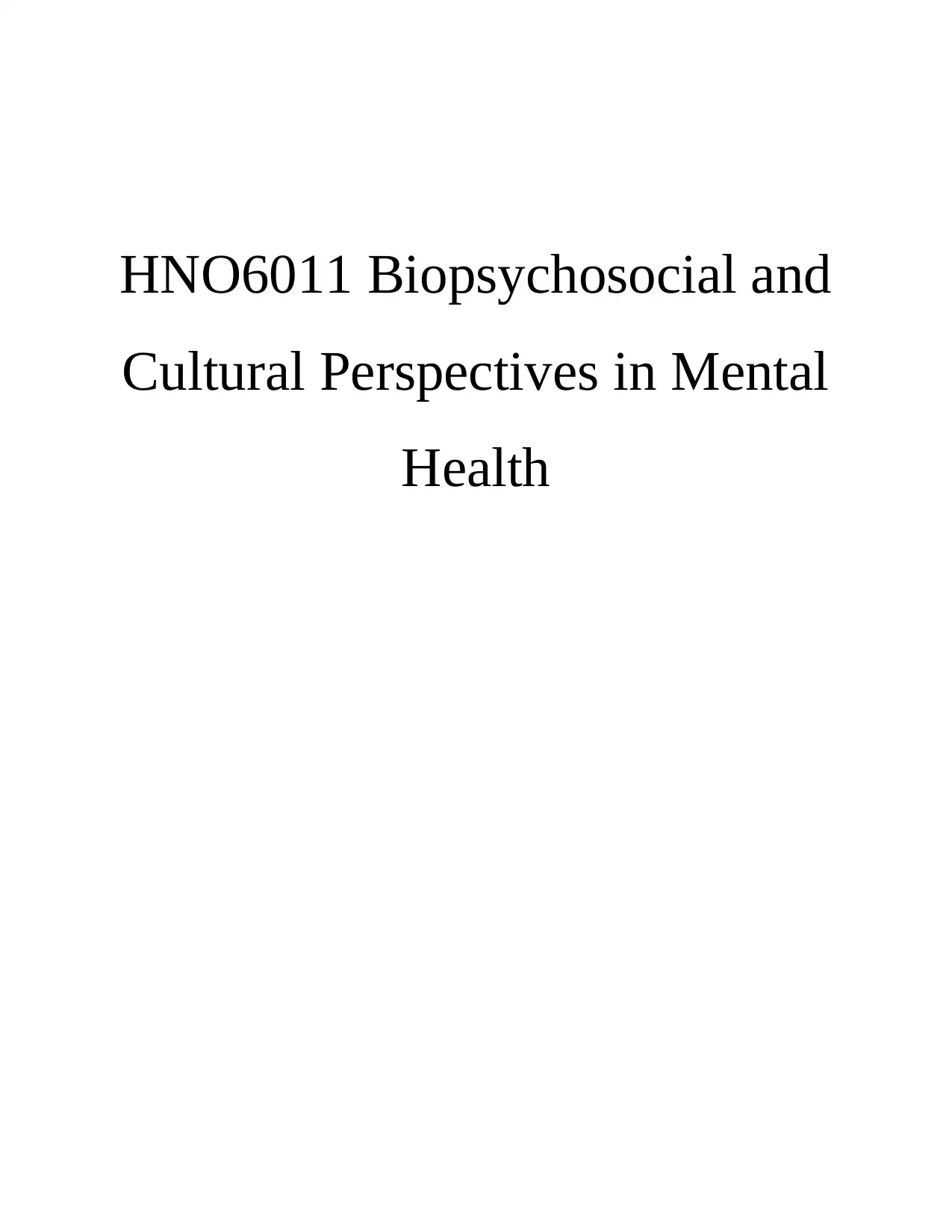
HNO6011 Biopsychosocial and
Cultural Perspectives in Mental
Health
Cultural Perspectives in Mental
Health
Paraphrase This Document
Need a fresh take? Get an instant paraphrase of this document with our AI Paraphraser
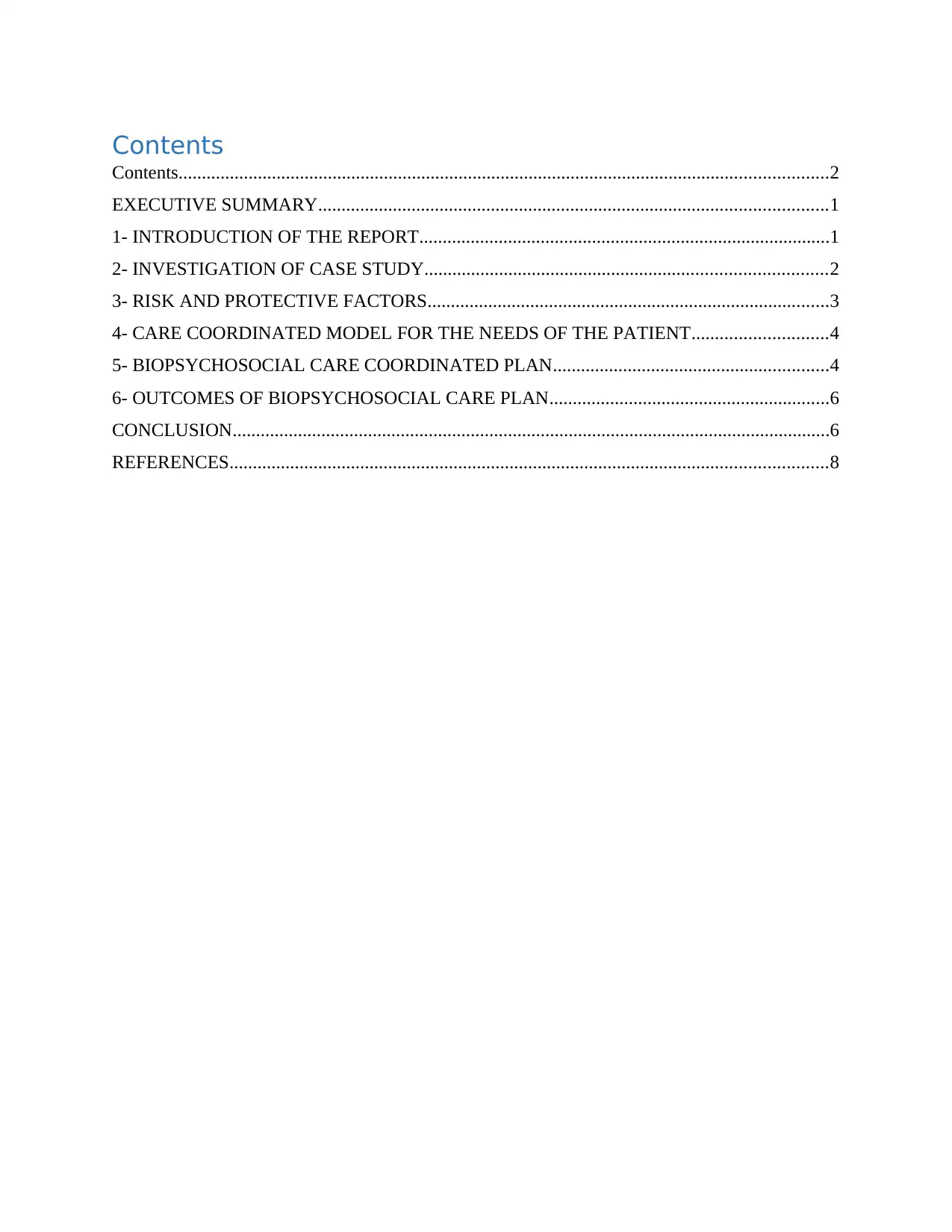
Contents
Contents...........................................................................................................................................2
EXECUTIVE SUMMARY.............................................................................................................1
1- INTRODUCTION OF THE REPORT........................................................................................1
2- INVESTIGATION OF CASE STUDY......................................................................................2
3- RISK AND PROTECTIVE FACTORS......................................................................................3
4- CARE COORDINATED MODEL FOR THE NEEDS OF THE PATIENT.............................4
5- BIOPSYCHOSOCIAL CARE COORDINATED PLAN...........................................................4
6- OUTCOMES OF BIOPSYCHOSOCIAL CARE PLAN............................................................6
CONCLUSION................................................................................................................................6
REFERENCES................................................................................................................................8
Contents...........................................................................................................................................2
EXECUTIVE SUMMARY.............................................................................................................1
1- INTRODUCTION OF THE REPORT........................................................................................1
2- INVESTIGATION OF CASE STUDY......................................................................................2
3- RISK AND PROTECTIVE FACTORS......................................................................................3
4- CARE COORDINATED MODEL FOR THE NEEDS OF THE PATIENT.............................4
5- BIOPSYCHOSOCIAL CARE COORDINATED PLAN...........................................................4
6- OUTCOMES OF BIOPSYCHOSOCIAL CARE PLAN............................................................6
CONCLUSION................................................................................................................................6
REFERENCES................................................................................................................................8

⊘ This is a preview!⊘
Do you want full access?
Subscribe today to unlock all pages.

Trusted by 1+ million students worldwide
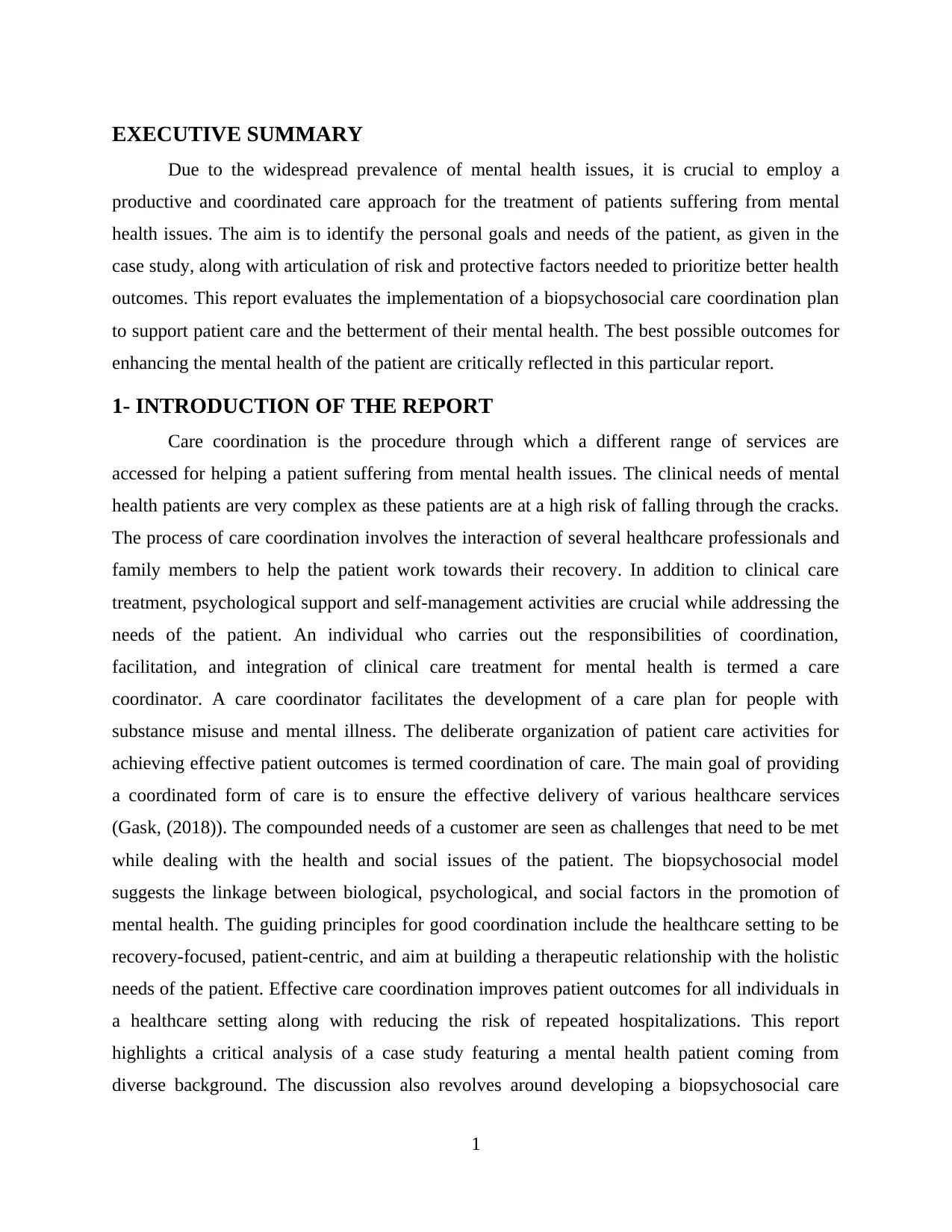
EXECUTIVE SUMMARY
Due to the widespread prevalence of mental health issues, it is crucial to employ a
productive and coordinated care approach for the treatment of patients suffering from mental
health issues. The aim is to identify the personal goals and needs of the patient, as given in the
case study, along with articulation of risk and protective factors needed to prioritize better health
outcomes. This report evaluates the implementation of a biopsychosocial care coordination plan
to support patient care and the betterment of their mental health. The best possible outcomes for
enhancing the mental health of the patient are critically reflected in this particular report.
1- INTRODUCTION OF THE REPORT
Care coordination is the procedure through which a different range of services are
accessed for helping a patient suffering from mental health issues. The clinical needs of mental
health patients are very complex as these patients are at a high risk of falling through the cracks.
The process of care coordination involves the interaction of several healthcare professionals and
family members to help the patient work towards their recovery. In addition to clinical care
treatment, psychological support and self-management activities are crucial while addressing the
needs of the patient. An individual who carries out the responsibilities of coordination,
facilitation, and integration of clinical care treatment for mental health is termed a care
coordinator. A care coordinator facilitates the development of a care plan for people with
substance misuse and mental illness. The deliberate organization of patient care activities for
achieving effective patient outcomes is termed coordination of care. The main goal of providing
a coordinated form of care is to ensure the effective delivery of various healthcare services
(Gask, (2018)). The compounded needs of a customer are seen as challenges that need to be met
while dealing with the health and social issues of the patient. The biopsychosocial model
suggests the linkage between biological, psychological, and social factors in the promotion of
mental health. The guiding principles for good coordination include the healthcare setting to be
recovery-focused, patient-centric, and aim at building a therapeutic relationship with the holistic
needs of the patient. Effective care coordination improves patient outcomes for all individuals in
a healthcare setting along with reducing the risk of repeated hospitalizations. This report
highlights a critical analysis of a case study featuring a mental health patient coming from
diverse background. The discussion also revolves around developing a biopsychosocial care
1
Due to the widespread prevalence of mental health issues, it is crucial to employ a
productive and coordinated care approach for the treatment of patients suffering from mental
health issues. The aim is to identify the personal goals and needs of the patient, as given in the
case study, along with articulation of risk and protective factors needed to prioritize better health
outcomes. This report evaluates the implementation of a biopsychosocial care coordination plan
to support patient care and the betterment of their mental health. The best possible outcomes for
enhancing the mental health of the patient are critically reflected in this particular report.
1- INTRODUCTION OF THE REPORT
Care coordination is the procedure through which a different range of services are
accessed for helping a patient suffering from mental health issues. The clinical needs of mental
health patients are very complex as these patients are at a high risk of falling through the cracks.
The process of care coordination involves the interaction of several healthcare professionals and
family members to help the patient work towards their recovery. In addition to clinical care
treatment, psychological support and self-management activities are crucial while addressing the
needs of the patient. An individual who carries out the responsibilities of coordination,
facilitation, and integration of clinical care treatment for mental health is termed a care
coordinator. A care coordinator facilitates the development of a care plan for people with
substance misuse and mental illness. The deliberate organization of patient care activities for
achieving effective patient outcomes is termed coordination of care. The main goal of providing
a coordinated form of care is to ensure the effective delivery of various healthcare services
(Gask, (2018)). The compounded needs of a customer are seen as challenges that need to be met
while dealing with the health and social issues of the patient. The biopsychosocial model
suggests the linkage between biological, psychological, and social factors in the promotion of
mental health. The guiding principles for good coordination include the healthcare setting to be
recovery-focused, patient-centric, and aim at building a therapeutic relationship with the holistic
needs of the patient. Effective care coordination improves patient outcomes for all individuals in
a healthcare setting along with reducing the risk of repeated hospitalizations. This report
highlights a critical analysis of a case study featuring a mental health patient coming from
diverse background. The discussion also revolves around developing a biopsychosocial care
1
Paraphrase This Document
Need a fresh take? Get an instant paraphrase of this document with our AI Paraphraser
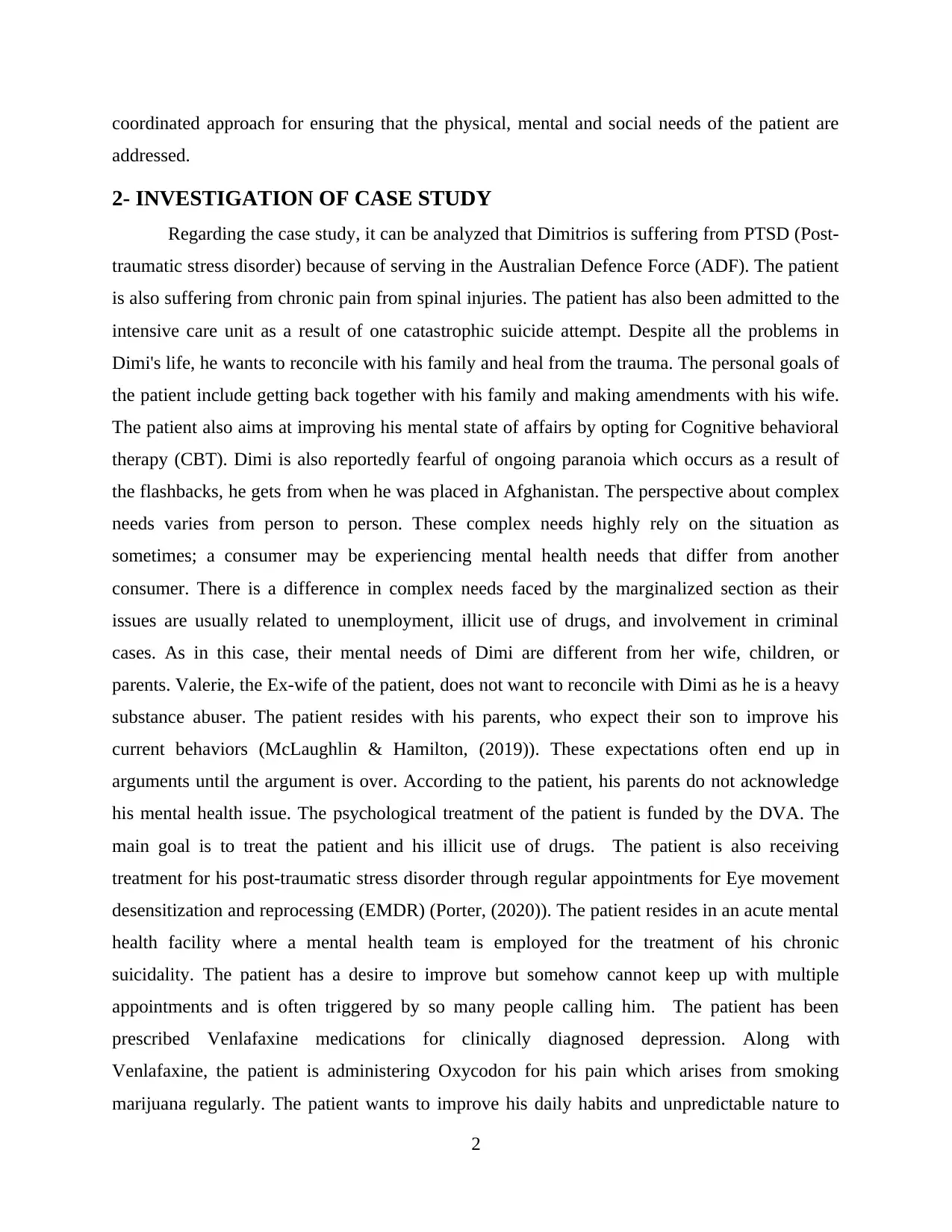
coordinated approach for ensuring that the physical, mental and social needs of the patient are
addressed.
2- INVESTIGATION OF CASE STUDY
Regarding the case study, it can be analyzed that Dimitrios is suffering from PTSD (Post-
traumatic stress disorder) because of serving in the Australian Defence Force (ADF). The patient
is also suffering from chronic pain from spinal injuries. The patient has also been admitted to the
intensive care unit as a result of one catastrophic suicide attempt. Despite all the problems in
Dimi's life, he wants to reconcile with his family and heal from the trauma. The personal goals of
the patient include getting back together with his family and making amendments with his wife.
The patient also aims at improving his mental state of affairs by opting for Cognitive behavioral
therapy (CBT). Dimi is also reportedly fearful of ongoing paranoia which occurs as a result of
the flashbacks, he gets from when he was placed in Afghanistan. The perspective about complex
needs varies from person to person. These complex needs highly rely on the situation as
sometimes; a consumer may be experiencing mental health needs that differ from another
consumer. There is a difference in complex needs faced by the marginalized section as their
issues are usually related to unemployment, illicit use of drugs, and involvement in criminal
cases. As in this case, their mental needs of Dimi are different from her wife, children, or
parents. Valerie, the Ex-wife of the patient, does not want to reconcile with Dimi as he is a heavy
substance abuser. The patient resides with his parents, who expect their son to improve his
current behaviors (McLaughlin & Hamilton, (2019)). These expectations often end up in
arguments until the argument is over. According to the patient, his parents do not acknowledge
his mental health issue. The psychological treatment of the patient is funded by the DVA. The
main goal is to treat the patient and his illicit use of drugs. The patient is also receiving
treatment for his post-traumatic stress disorder through regular appointments for Eye movement
desensitization and reprocessing (EMDR) (Porter, (2020)). The patient resides in an acute mental
health facility where a mental health team is employed for the treatment of his chronic
suicidality. The patient has a desire to improve but somehow cannot keep up with multiple
appointments and is often triggered by so many people calling him. The patient has been
prescribed Venlafaxine medications for clinically diagnosed depression. Along with
Venlafaxine, the patient is administering Oxycodon for his pain which arises from smoking
marijuana regularly. The patient wants to improve his daily habits and unpredictable nature to
2
addressed.
2- INVESTIGATION OF CASE STUDY
Regarding the case study, it can be analyzed that Dimitrios is suffering from PTSD (Post-
traumatic stress disorder) because of serving in the Australian Defence Force (ADF). The patient
is also suffering from chronic pain from spinal injuries. The patient has also been admitted to the
intensive care unit as a result of one catastrophic suicide attempt. Despite all the problems in
Dimi's life, he wants to reconcile with his family and heal from the trauma. The personal goals of
the patient include getting back together with his family and making amendments with his wife.
The patient also aims at improving his mental state of affairs by opting for Cognitive behavioral
therapy (CBT). Dimi is also reportedly fearful of ongoing paranoia which occurs as a result of
the flashbacks, he gets from when he was placed in Afghanistan. The perspective about complex
needs varies from person to person. These complex needs highly rely on the situation as
sometimes; a consumer may be experiencing mental health needs that differ from another
consumer. There is a difference in complex needs faced by the marginalized section as their
issues are usually related to unemployment, illicit use of drugs, and involvement in criminal
cases. As in this case, their mental needs of Dimi are different from her wife, children, or
parents. Valerie, the Ex-wife of the patient, does not want to reconcile with Dimi as he is a heavy
substance abuser. The patient resides with his parents, who expect their son to improve his
current behaviors (McLaughlin & Hamilton, (2019)). These expectations often end up in
arguments until the argument is over. According to the patient, his parents do not acknowledge
his mental health issue. The psychological treatment of the patient is funded by the DVA. The
main goal is to treat the patient and his illicit use of drugs. The patient is also receiving
treatment for his post-traumatic stress disorder through regular appointments for Eye movement
desensitization and reprocessing (EMDR) (Porter, (2020)). The patient resides in an acute mental
health facility where a mental health team is employed for the treatment of his chronic
suicidality. The patient has a desire to improve but somehow cannot keep up with multiple
appointments and is often triggered by so many people calling him. The patient has been
prescribed Venlafaxine medications for clinically diagnosed depression. Along with
Venlafaxine, the patient is administering Oxycodon for his pain which arises from smoking
marijuana regularly. The patient wants to improve his daily habits and unpredictable nature to
2
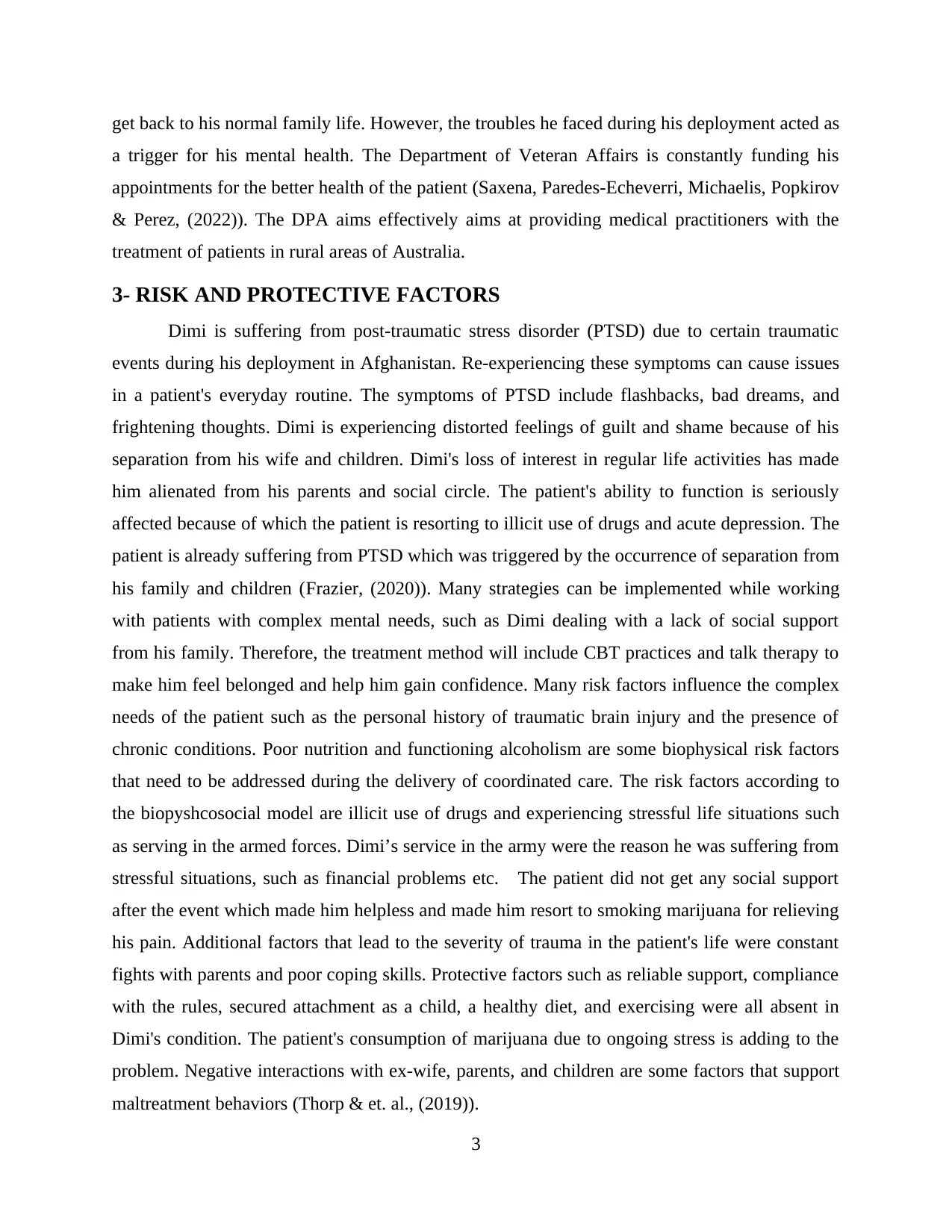
get back to his normal family life. However, the troubles he faced during his deployment acted as
a trigger for his mental health. The Department of Veteran Affairs is constantly funding his
appointments for the better health of the patient (Saxena, Paredes-Echeverri, Michaelis, Popkirov
& Perez, (2022)). The DPA aims effectively aims at providing medical practitioners with the
treatment of patients in rural areas of Australia.
3- RISK AND PROTECTIVE FACTORS
Dimi is suffering from post-traumatic stress disorder (PTSD) due to certain traumatic
events during his deployment in Afghanistan. Re-experiencing these symptoms can cause issues
in a patient's everyday routine. The symptoms of PTSD include flashbacks, bad dreams, and
frightening thoughts. Dimi is experiencing distorted feelings of guilt and shame because of his
separation from his wife and children. Dimi's loss of interest in regular life activities has made
him alienated from his parents and social circle. The patient's ability to function is seriously
affected because of which the patient is resorting to illicit use of drugs and acute depression. The
patient is already suffering from PTSD which was triggered by the occurrence of separation from
his family and children (Frazier, (2020)). Many strategies can be implemented while working
with patients with complex mental needs, such as Dimi dealing with a lack of social support
from his family. Therefore, the treatment method will include CBT practices and talk therapy to
make him feel belonged and help him gain confidence. Many risk factors influence the complex
needs of the patient such as the personal history of traumatic brain injury and the presence of
chronic conditions. Poor nutrition and functioning alcoholism are some biophysical risk factors
that need to be addressed during the delivery of coordinated care. The risk factors according to
the biopyshcosocial model are illicit use of drugs and experiencing stressful life situations such
as serving in the armed forces. Dimi’s service in the army were the reason he was suffering from
stressful situations, such as financial problems etc. The patient did not get any social support
after the event which made him helpless and made him resort to smoking marijuana for relieving
his pain. Additional factors that lead to the severity of trauma in the patient's life were constant
fights with parents and poor coping skills. Protective factors such as reliable support, compliance
with the rules, secured attachment as a child, a healthy diet, and exercising were all absent in
Dimi's condition. The patient's consumption of marijuana due to ongoing stress is adding to the
problem. Negative interactions with ex-wife, parents, and children are some factors that support
maltreatment behaviors (Thorp & et. al., (2019)).
3
a trigger for his mental health. The Department of Veteran Affairs is constantly funding his
appointments for the better health of the patient (Saxena, Paredes-Echeverri, Michaelis, Popkirov
& Perez, (2022)). The DPA aims effectively aims at providing medical practitioners with the
treatment of patients in rural areas of Australia.
3- RISK AND PROTECTIVE FACTORS
Dimi is suffering from post-traumatic stress disorder (PTSD) due to certain traumatic
events during his deployment in Afghanistan. Re-experiencing these symptoms can cause issues
in a patient's everyday routine. The symptoms of PTSD include flashbacks, bad dreams, and
frightening thoughts. Dimi is experiencing distorted feelings of guilt and shame because of his
separation from his wife and children. Dimi's loss of interest in regular life activities has made
him alienated from his parents and social circle. The patient's ability to function is seriously
affected because of which the patient is resorting to illicit use of drugs and acute depression. The
patient is already suffering from PTSD which was triggered by the occurrence of separation from
his family and children (Frazier, (2020)). Many strategies can be implemented while working
with patients with complex mental needs, such as Dimi dealing with a lack of social support
from his family. Therefore, the treatment method will include CBT practices and talk therapy to
make him feel belonged and help him gain confidence. Many risk factors influence the complex
needs of the patient such as the personal history of traumatic brain injury and the presence of
chronic conditions. Poor nutrition and functioning alcoholism are some biophysical risk factors
that need to be addressed during the delivery of coordinated care. The risk factors according to
the biopyshcosocial model are illicit use of drugs and experiencing stressful life situations such
as serving in the armed forces. Dimi’s service in the army were the reason he was suffering from
stressful situations, such as financial problems etc. The patient did not get any social support
after the event which made him helpless and made him resort to smoking marijuana for relieving
his pain. Additional factors that lead to the severity of trauma in the patient's life were constant
fights with parents and poor coping skills. Protective factors such as reliable support, compliance
with the rules, secured attachment as a child, a healthy diet, and exercising were all absent in
Dimi's condition. The patient's consumption of marijuana due to ongoing stress is adding to the
problem. Negative interactions with ex-wife, parents, and children are some factors that support
maltreatment behaviors (Thorp & et. al., (2019)).
3
⊘ This is a preview!⊘
Do you want full access?
Subscribe today to unlock all pages.

Trusted by 1+ million students worldwide
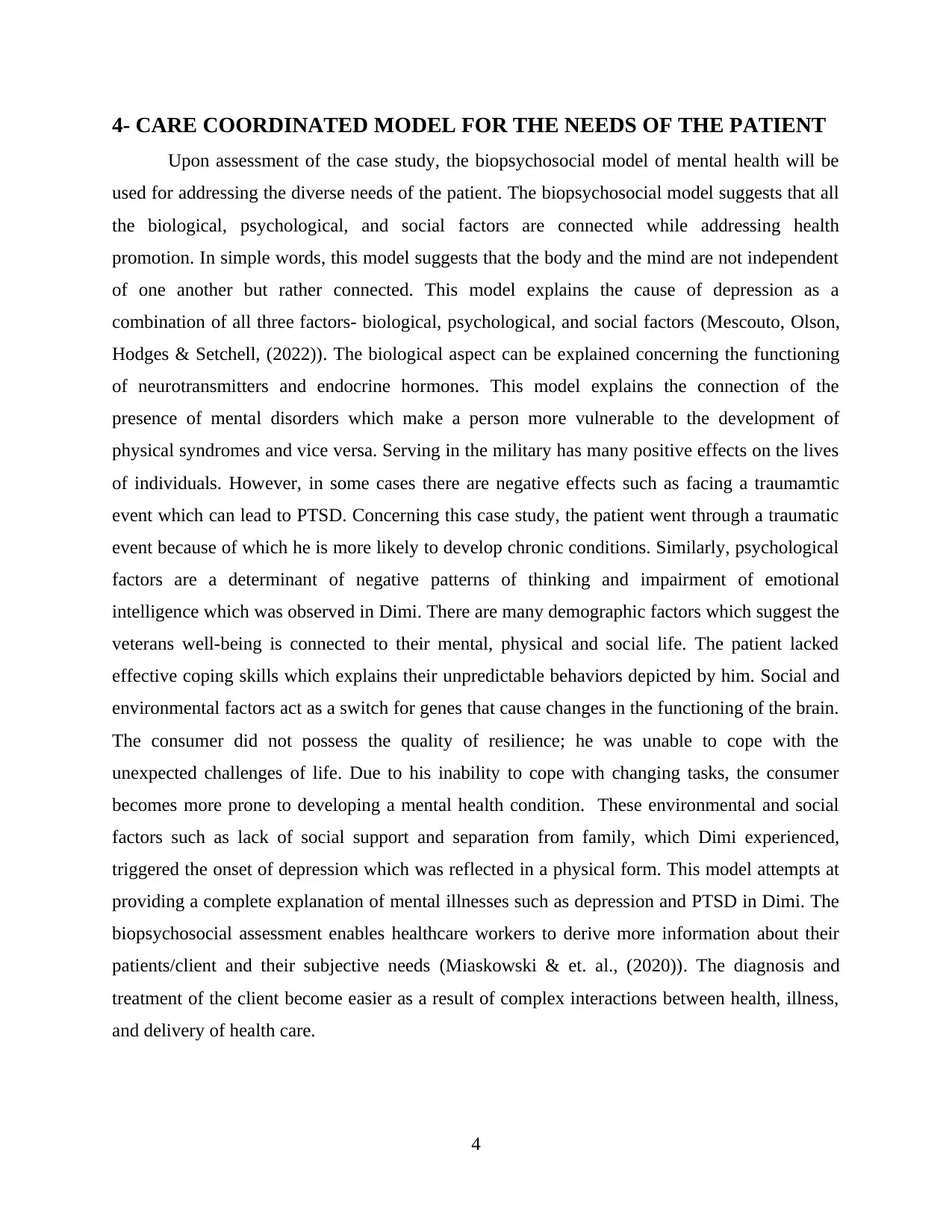
4- CARE COORDINATED MODEL FOR THE NEEDS OF THE PATIENT
Upon assessment of the case study, the biopsychosocial model of mental health will be
used for addressing the diverse needs of the patient. The biopsychosocial model suggests that all
the biological, psychological, and social factors are connected while addressing health
promotion. In simple words, this model suggests that the body and the mind are not independent
of one another but rather connected. This model explains the cause of depression as a
combination of all three factors- biological, psychological, and social factors (Mescouto, Olson,
Hodges & Setchell, (2022)). The biological aspect can be explained concerning the functioning
of neurotransmitters and endocrine hormones. This model explains the connection of the
presence of mental disorders which make a person more vulnerable to the development of
physical syndromes and vice versa. Serving in the military has many positive effects on the lives
of individuals. However, in some cases there are negative effects such as facing a traumamtic
event which can lead to PTSD. Concerning this case study, the patient went through a traumatic
event because of which he is more likely to develop chronic conditions. Similarly, psychological
factors are a determinant of negative patterns of thinking and impairment of emotional
intelligence which was observed in Dimi. There are many demographic factors which suggest the
veterans well-being is connected to their mental, physical and social life. The patient lacked
effective coping skills which explains their unpredictable behaviors depicted by him. Social and
environmental factors act as a switch for genes that cause changes in the functioning of the brain.
The consumer did not possess the quality of resilience; he was unable to cope with the
unexpected challenges of life. Due to his inability to cope with changing tasks, the consumer
becomes more prone to developing a mental health condition. These environmental and social
factors such as lack of social support and separation from family, which Dimi experienced,
triggered the onset of depression which was reflected in a physical form. This model attempts at
providing a complete explanation of mental illnesses such as depression and PTSD in Dimi. The
biopsychosocial assessment enables healthcare workers to derive more information about their
patients/client and their subjective needs (Miaskowski & et. al., (2020)). The diagnosis and
treatment of the client become easier as a result of complex interactions between health, illness,
and delivery of health care.
4
Upon assessment of the case study, the biopsychosocial model of mental health will be
used for addressing the diverse needs of the patient. The biopsychosocial model suggests that all
the biological, psychological, and social factors are connected while addressing health
promotion. In simple words, this model suggests that the body and the mind are not independent
of one another but rather connected. This model explains the cause of depression as a
combination of all three factors- biological, psychological, and social factors (Mescouto, Olson,
Hodges & Setchell, (2022)). The biological aspect can be explained concerning the functioning
of neurotransmitters and endocrine hormones. This model explains the connection of the
presence of mental disorders which make a person more vulnerable to the development of
physical syndromes and vice versa. Serving in the military has many positive effects on the lives
of individuals. However, in some cases there are negative effects such as facing a traumamtic
event which can lead to PTSD. Concerning this case study, the patient went through a traumatic
event because of which he is more likely to develop chronic conditions. Similarly, psychological
factors are a determinant of negative patterns of thinking and impairment of emotional
intelligence which was observed in Dimi. There are many demographic factors which suggest the
veterans well-being is connected to their mental, physical and social life. The patient lacked
effective coping skills which explains their unpredictable behaviors depicted by him. Social and
environmental factors act as a switch for genes that cause changes in the functioning of the brain.
The consumer did not possess the quality of resilience; he was unable to cope with the
unexpected challenges of life. Due to his inability to cope with changing tasks, the consumer
becomes more prone to developing a mental health condition. These environmental and social
factors such as lack of social support and separation from family, which Dimi experienced,
triggered the onset of depression which was reflected in a physical form. This model attempts at
providing a complete explanation of mental illnesses such as depression and PTSD in Dimi. The
biopsychosocial assessment enables healthcare workers to derive more information about their
patients/client and their subjective needs (Miaskowski & et. al., (2020)). The diagnosis and
treatment of the client become easier as a result of complex interactions between health, illness,
and delivery of health care.
4
Paraphrase This Document
Need a fresh take? Get an instant paraphrase of this document with our AI Paraphraser
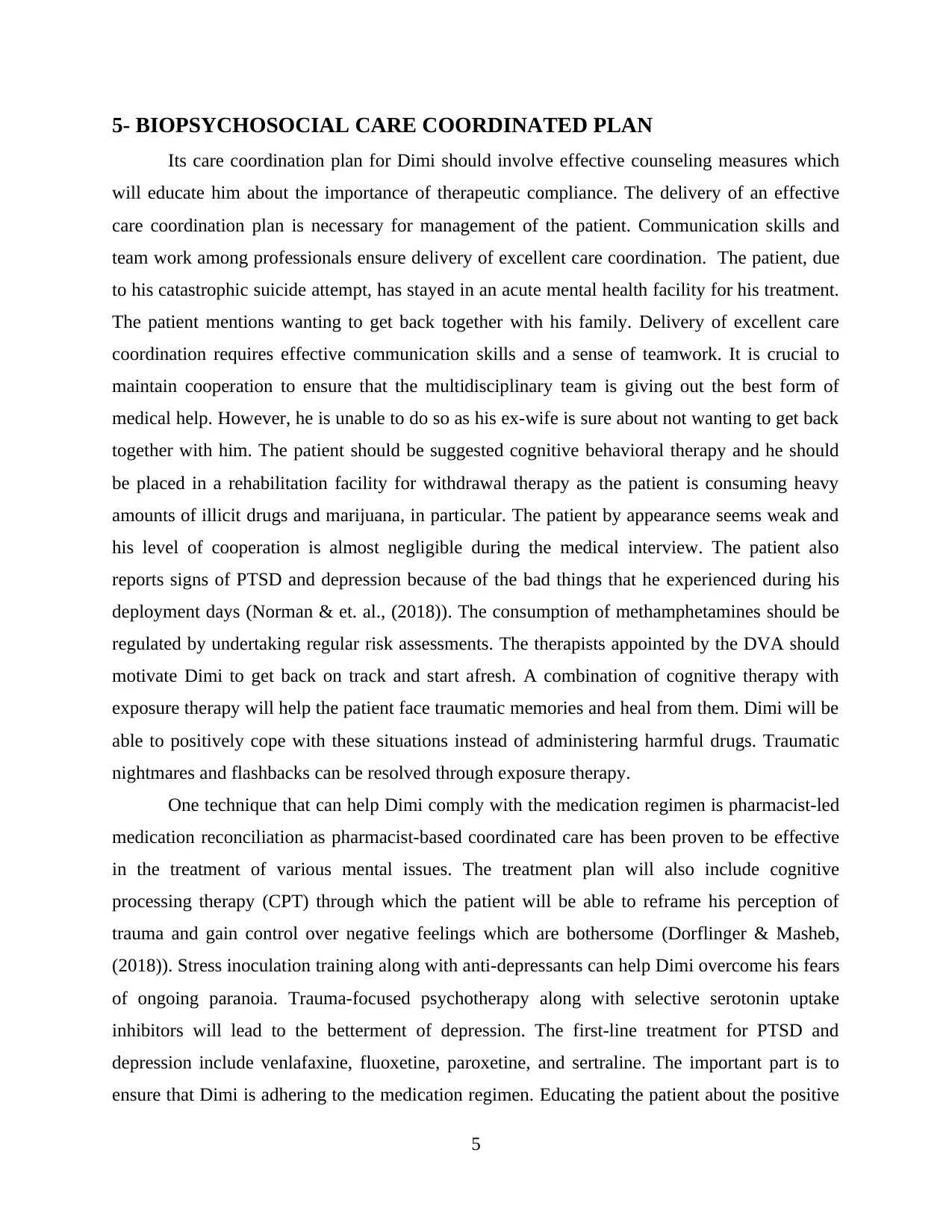
5- BIOPSYCHOSOCIAL CARE COORDINATED PLAN
Its care coordination plan for Dimi should involve effective counseling measures which
will educate him about the importance of therapeutic compliance. The delivery of an effective
care coordination plan is necessary for management of the patient. Communication skills and
team work among professionals ensure delivery of excellent care coordination. The patient, due
to his catastrophic suicide attempt, has stayed in an acute mental health facility for his treatment.
The patient mentions wanting to get back together with his family. Delivery of excellent care
coordination requires effective communication skills and a sense of teamwork. It is crucial to
maintain cooperation to ensure that the multidisciplinary team is giving out the best form of
medical help. However, he is unable to do so as his ex-wife is sure about not wanting to get back
together with him. The patient should be suggested cognitive behavioral therapy and he should
be placed in a rehabilitation facility for withdrawal therapy as the patient is consuming heavy
amounts of illicit drugs and marijuana, in particular. The patient by appearance seems weak and
his level of cooperation is almost negligible during the medical interview. The patient also
reports signs of PTSD and depression because of the bad things that he experienced during his
deployment days (Norman & et. al., (2018)). The consumption of methamphetamines should be
regulated by undertaking regular risk assessments. The therapists appointed by the DVA should
motivate Dimi to get back on track and start afresh. A combination of cognitive therapy with
exposure therapy will help the patient face traumatic memories and heal from them. Dimi will be
able to positively cope with these situations instead of administering harmful drugs. Traumatic
nightmares and flashbacks can be resolved through exposure therapy.
One technique that can help Dimi comply with the medication regimen is pharmacist-led
medication reconciliation as pharmacist-based coordinated care has been proven to be effective
in the treatment of various mental issues. The treatment plan will also include cognitive
processing therapy (CPT) through which the patient will be able to reframe his perception of
trauma and gain control over negative feelings which are bothersome (Dorflinger & Masheb,
(2018)). Stress inoculation training along with anti-depressants can help Dimi overcome his fears
of ongoing paranoia. Trauma-focused psychotherapy along with selective serotonin uptake
inhibitors will lead to the betterment of depression. The first-line treatment for PTSD and
depression include venlafaxine, fluoxetine, paroxetine, and sertraline. The important part is to
ensure that Dimi is adhering to the medication regimen. Educating the patient about the positive
5
Its care coordination plan for Dimi should involve effective counseling measures which
will educate him about the importance of therapeutic compliance. The delivery of an effective
care coordination plan is necessary for management of the patient. Communication skills and
team work among professionals ensure delivery of excellent care coordination. The patient, due
to his catastrophic suicide attempt, has stayed in an acute mental health facility for his treatment.
The patient mentions wanting to get back together with his family. Delivery of excellent care
coordination requires effective communication skills and a sense of teamwork. It is crucial to
maintain cooperation to ensure that the multidisciplinary team is giving out the best form of
medical help. However, he is unable to do so as his ex-wife is sure about not wanting to get back
together with him. The patient should be suggested cognitive behavioral therapy and he should
be placed in a rehabilitation facility for withdrawal therapy as the patient is consuming heavy
amounts of illicit drugs and marijuana, in particular. The patient by appearance seems weak and
his level of cooperation is almost negligible during the medical interview. The patient also
reports signs of PTSD and depression because of the bad things that he experienced during his
deployment days (Norman & et. al., (2018)). The consumption of methamphetamines should be
regulated by undertaking regular risk assessments. The therapists appointed by the DVA should
motivate Dimi to get back on track and start afresh. A combination of cognitive therapy with
exposure therapy will help the patient face traumatic memories and heal from them. Dimi will be
able to positively cope with these situations instead of administering harmful drugs. Traumatic
nightmares and flashbacks can be resolved through exposure therapy.
One technique that can help Dimi comply with the medication regimen is pharmacist-led
medication reconciliation as pharmacist-based coordinated care has been proven to be effective
in the treatment of various mental issues. The treatment plan will also include cognitive
processing therapy (CPT) through which the patient will be able to reframe his perception of
trauma and gain control over negative feelings which are bothersome (Dorflinger & Masheb,
(2018)). Stress inoculation training along with anti-depressants can help Dimi overcome his fears
of ongoing paranoia. Trauma-focused psychotherapy along with selective serotonin uptake
inhibitors will lead to the betterment of depression. The first-line treatment for PTSD and
depression include venlafaxine, fluoxetine, paroxetine, and sertraline. The important part is to
ensure that Dimi is adhering to the medication regimen. Educating the patient about the positive
5

effect of medication adherence with the use of technology. For improving medication adherence,
it is crucial to nurture relationships with patients and help them by providing appropriate support
emotionally and mentally. Implementation of team-based care empowers patients to properly
understand their treatment procedure for their benefit (Meyer & et. al., (2019)). The patient is
seen as suffering from a financial crisis because of which it is necessary to reduce the barriers to
obtaining medication. These measures should include a reduction in costs of medications and
lowering economic barriers for patients suffering from mental health conditions.
6- OUTCOMES OF BIOPSYCHOSOCIAL CARE PLAN
The outcomes of biopsychosocial care coordination will involve significant improvement
in the mental health of the patient. The patient will heal from suicidal and depressive episodes
and will no longer be a threat to himself and his family. The improvement in his habits will give
him access to meeting his children. The outcomes of improving consumer care will be effective
when care coordination facilities are addressed for the vulnerable and marginalized populations.
The use of anti-depressants and talk therapy will help Dimi in healing from post-traumatic stress
disorder which developed during his deployment. Rehabilitation therapy will help in reducing
the impact of a broad range of health conditions such as depression and its associated risk factors
(Wharton & et. al., (2019)). Cognitive behavioral therapy will help Dimi in making his problems
more manageable. The negative thought patterns of the patient will change and there will be a
significant improvement in the way they feel through exposure therapy. The neural pathways of
the brain will be altered and the negative cycle of anxiety will be shattered. These changes along
with the use of anti-depressants will help Dimi lead a normal life by increasing the levels of
certain neurotransmitters in the brain- serotonin, and noradrenaline which regulate mood and
emotions in daily lives.
CONCLUSION
From the above report, it can be concluded that a complete analysis of Dimi's case study
was conducted where all ranges of physical, mental, and social needs of the patient, his family,
and care workers were identified. Furthermore, the consumer's protective and risk factors were
articulated based on the physical assessment conducted. According to the diverse needs of the
consumer, appropriate care coordinated plan, using the biopsychosocial model, was chosen
6
it is crucial to nurture relationships with patients and help them by providing appropriate support
emotionally and mentally. Implementation of team-based care empowers patients to properly
understand their treatment procedure for their benefit (Meyer & et. al., (2019)). The patient is
seen as suffering from a financial crisis because of which it is necessary to reduce the barriers to
obtaining medication. These measures should include a reduction in costs of medications and
lowering economic barriers for patients suffering from mental health conditions.
6- OUTCOMES OF BIOPSYCHOSOCIAL CARE PLAN
The outcomes of biopsychosocial care coordination will involve significant improvement
in the mental health of the patient. The patient will heal from suicidal and depressive episodes
and will no longer be a threat to himself and his family. The improvement in his habits will give
him access to meeting his children. The outcomes of improving consumer care will be effective
when care coordination facilities are addressed for the vulnerable and marginalized populations.
The use of anti-depressants and talk therapy will help Dimi in healing from post-traumatic stress
disorder which developed during his deployment. Rehabilitation therapy will help in reducing
the impact of a broad range of health conditions such as depression and its associated risk factors
(Wharton & et. al., (2019)). Cognitive behavioral therapy will help Dimi in making his problems
more manageable. The negative thought patterns of the patient will change and there will be a
significant improvement in the way they feel through exposure therapy. The neural pathways of
the brain will be altered and the negative cycle of anxiety will be shattered. These changes along
with the use of anti-depressants will help Dimi lead a normal life by increasing the levels of
certain neurotransmitters in the brain- serotonin, and noradrenaline which regulate mood and
emotions in daily lives.
CONCLUSION
From the above report, it can be concluded that a complete analysis of Dimi's case study
was conducted where all ranges of physical, mental, and social needs of the patient, his family,
and care workers were identified. Furthermore, the consumer's protective and risk factors were
articulated based on the physical assessment conducted. According to the diverse needs of the
consumer, appropriate care coordinated plan, using the biopsychosocial model, was chosen
6
⊘ This is a preview!⊘
Do you want full access?
Subscribe today to unlock all pages.

Trusted by 1+ million students worldwide

which will help the patient achieve his goals. Moving on, a critical reflection on the best possible
outcomes of the care plan was conducted which led to the consumer achieving their goals.
7
outcomes of the care plan was conducted which led to the consumer achieving their goals.
7
Paraphrase This Document
Need a fresh take? Get an instant paraphrase of this document with our AI Paraphraser
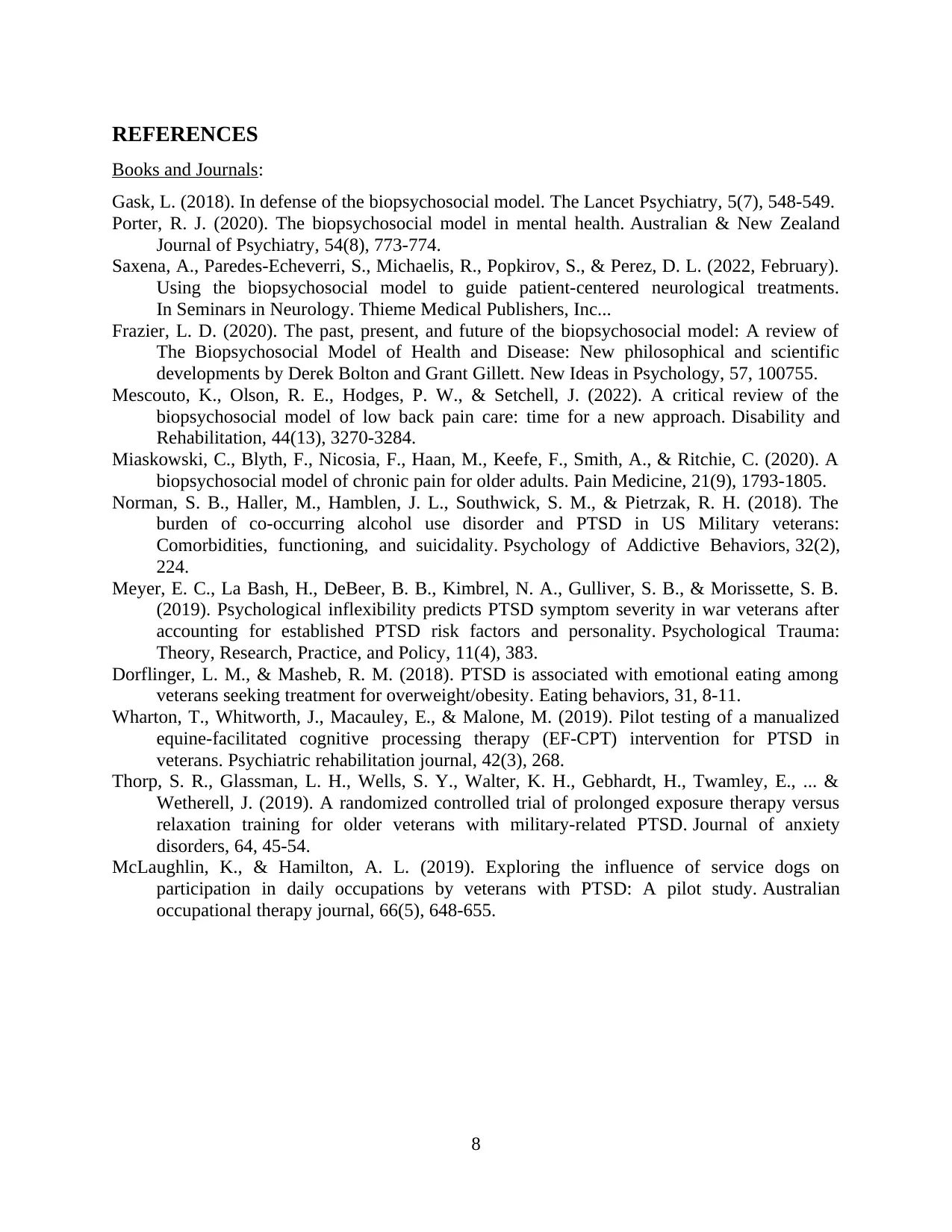
REFERENCES
Books and Journals:
Gask, L. (2018). In defense of the biopsychosocial model. The Lancet Psychiatry, 5(7), 548-549.
Porter, R. J. (2020). The biopsychosocial model in mental health. Australian & New Zealand
Journal of Psychiatry, 54(8), 773-774.
Saxena, A., Paredes-Echeverri, S., Michaelis, R., Popkirov, S., & Perez, D. L. (2022, February).
Using the biopsychosocial model to guide patient-centered neurological treatments.
In Seminars in Neurology. Thieme Medical Publishers, Inc...
Frazier, L. D. (2020). The past, present, and future of the biopsychosocial model: A review of
The Biopsychosocial Model of Health and Disease: New philosophical and scientific
developments by Derek Bolton and Grant Gillett. New Ideas in Psychology, 57, 100755.
Mescouto, K., Olson, R. E., Hodges, P. W., & Setchell, J. (2022). A critical review of the
biopsychosocial model of low back pain care: time for a new approach. Disability and
Rehabilitation, 44(13), 3270-3284.
Miaskowski, C., Blyth, F., Nicosia, F., Haan, M., Keefe, F., Smith, A., & Ritchie, C. (2020). A
biopsychosocial model of chronic pain for older adults. Pain Medicine, 21(9), 1793-1805.
Norman, S. B., Haller, M., Hamblen, J. L., Southwick, S. M., & Pietrzak, R. H. (2018). The
burden of co-occurring alcohol use disorder and PTSD in US Military veterans:
Comorbidities, functioning, and suicidality. Psychology of Addictive Behaviors, 32(2),
224.
Meyer, E. C., La Bash, H., DeBeer, B. B., Kimbrel, N. A., Gulliver, S. B., & Morissette, S. B.
(2019). Psychological inflexibility predicts PTSD symptom severity in war veterans after
accounting for established PTSD risk factors and personality. Psychological Trauma:
Theory, Research, Practice, and Policy, 11(4), 383.
Dorflinger, L. M., & Masheb, R. M. (2018). PTSD is associated with emotional eating among
veterans seeking treatment for overweight/obesity. Eating behaviors, 31, 8-11.
Wharton, T., Whitworth, J., Macauley, E., & Malone, M. (2019). Pilot testing of a manualized
equine-facilitated cognitive processing therapy (EF-CPT) intervention for PTSD in
veterans. Psychiatric rehabilitation journal, 42(3), 268.
Thorp, S. R., Glassman, L. H., Wells, S. Y., Walter, K. H., Gebhardt, H., Twamley, E., ... &
Wetherell, J. (2019). A randomized controlled trial of prolonged exposure therapy versus
relaxation training for older veterans with military-related PTSD. Journal of anxiety
disorders, 64, 45-54.
McLaughlin, K., & Hamilton, A. L. (2019). Exploring the influence of service dogs on
participation in daily occupations by veterans with PTSD: A pilot study. Australian
occupational therapy journal, 66(5), 648-655.
8
Books and Journals:
Gask, L. (2018). In defense of the biopsychosocial model. The Lancet Psychiatry, 5(7), 548-549.
Porter, R. J. (2020). The biopsychosocial model in mental health. Australian & New Zealand
Journal of Psychiatry, 54(8), 773-774.
Saxena, A., Paredes-Echeverri, S., Michaelis, R., Popkirov, S., & Perez, D. L. (2022, February).
Using the biopsychosocial model to guide patient-centered neurological treatments.
In Seminars in Neurology. Thieme Medical Publishers, Inc...
Frazier, L. D. (2020). The past, present, and future of the biopsychosocial model: A review of
The Biopsychosocial Model of Health and Disease: New philosophical and scientific
developments by Derek Bolton and Grant Gillett. New Ideas in Psychology, 57, 100755.
Mescouto, K., Olson, R. E., Hodges, P. W., & Setchell, J. (2022). A critical review of the
biopsychosocial model of low back pain care: time for a new approach. Disability and
Rehabilitation, 44(13), 3270-3284.
Miaskowski, C., Blyth, F., Nicosia, F., Haan, M., Keefe, F., Smith, A., & Ritchie, C. (2020). A
biopsychosocial model of chronic pain for older adults. Pain Medicine, 21(9), 1793-1805.
Norman, S. B., Haller, M., Hamblen, J. L., Southwick, S. M., & Pietrzak, R. H. (2018). The
burden of co-occurring alcohol use disorder and PTSD in US Military veterans:
Comorbidities, functioning, and suicidality. Psychology of Addictive Behaviors, 32(2),
224.
Meyer, E. C., La Bash, H., DeBeer, B. B., Kimbrel, N. A., Gulliver, S. B., & Morissette, S. B.
(2019). Psychological inflexibility predicts PTSD symptom severity in war veterans after
accounting for established PTSD risk factors and personality. Psychological Trauma:
Theory, Research, Practice, and Policy, 11(4), 383.
Dorflinger, L. M., & Masheb, R. M. (2018). PTSD is associated with emotional eating among
veterans seeking treatment for overweight/obesity. Eating behaviors, 31, 8-11.
Wharton, T., Whitworth, J., Macauley, E., & Malone, M. (2019). Pilot testing of a manualized
equine-facilitated cognitive processing therapy (EF-CPT) intervention for PTSD in
veterans. Psychiatric rehabilitation journal, 42(3), 268.
Thorp, S. R., Glassman, L. H., Wells, S. Y., Walter, K. H., Gebhardt, H., Twamley, E., ... &
Wetherell, J. (2019). A randomized controlled trial of prolonged exposure therapy versus
relaxation training for older veterans with military-related PTSD. Journal of anxiety
disorders, 64, 45-54.
McLaughlin, K., & Hamilton, A. L. (2019). Exploring the influence of service dogs on
participation in daily occupations by veterans with PTSD: A pilot study. Australian
occupational therapy journal, 66(5), 648-655.
8
1 out of 11
Related Documents
Your All-in-One AI-Powered Toolkit for Academic Success.
+13062052269
info@desklib.com
Available 24*7 on WhatsApp / Email
![[object Object]](/_next/static/media/star-bottom.7253800d.svg)
Unlock your academic potential
Copyright © 2020–2025 A2Z Services. All Rights Reserved. Developed and managed by ZUCOL.





